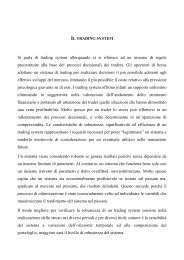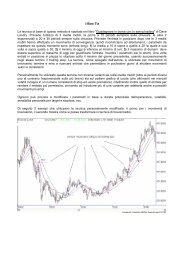Swing Trading Using Candlestick charting - ASD Forex
Swing Trading Using Candlestick charting - ASD Forex
Swing Trading Using Candlestick charting - ASD Forex
Create successful ePaper yourself
Turn your PDF publications into a flip-book with our unique Google optimized e-Paper software.
For the first support take the pivot point number times two and then subtract the high. (Px2)-H = Support 1<br />
<strong>Swing</strong> <strong>Trading</strong>, pg. 2<br />
For the second support, take the pivot point number subtract the high and then add the low. P-H+L= Support 2<br />
All right, now that we have that established you can see it is a detailed formula. So let’s try to simplify it. Consider<br />
the Pivot Point as the average of the previous sessions trading range combined with the closing price. The<br />
numbers of support and resistance that are calculated indicate the potential ranges for the next time frame based<br />
on the past weight of the markets strength or weakness derived from the calculations of the high, low and distance<br />
from the close of those points. Pivot Point analysis is also used for identifying breakout points from the support and<br />
resistance numbers.<br />
The previous sessions trading range could be based and calculated for an hour, a day, a week or a month. Most<br />
trading software includes these numbers on a daily basis so that you do not have the tedious chore of doing it the<br />
old fashion way, by hand using a calculator. The really old fashion way doesn’t use a calculator. Don’t make your<br />
job harder try the easy way.<br />
I wrote a computer program so that I can calculate the numbers on a daily, weekly and monthly time period<br />
relatively quick and for most markets. These calculations are available to clients by Fax, email or by viewing on line.<br />
Clients and visitors have access to this research by going to my website www.nationalfutures.com .<br />
I personally do the daily numbers at the end of the day in order to help me identify the next day’s potential range or<br />
support and resistance. It gives me a head start on my research so I am prepared for the next day’s work. It helps<br />
me to plan my trades. Similarly the weekly numbers are done at the end of every week and the same goes for the<br />
monthly numbers.<br />
Since most technical analysis is derived from mathematical calculations the common denominators that are used<br />
are the high, low, close and the open. This is what is used for plotting a bar chart. More notarized techniques like<br />
Moving averages, Relative Strength Index, Stochastics, and Fibonacci numbers are all calculated using<br />
mathematics based on those points of interest. It is also what is published in the Newspapers. It is there for a<br />
reason.<br />
The concept is this, as technical analysts we are trying to use past price behavior to help us indicate future price<br />
direction. l I am not trying to predict the future I just want an Idea of where prices can go in a given time period<br />
based on where they have been. After all isn’t that similar to the concept of drawing trend lines<br />
CHAPTER 2<br />
We have all heard the slogan about how to be successful in investing in Real Estate, which is LOCATION,<br />
LOCATION, and LOCATION. (Check that out another symbolic reference that involves the Fibonacci number<br />
three).<br />
In this business it is important to remember what I call the rule of MULTIPLE VERIFICATION. I more than likely<br />
picked this belief by reading a book back in 1981 0r 1982 by Arthur Sklarew. He wrote in his book titled Techniques<br />
of a Professional Commodity Chart Analyst, about The Rule of Multiple Techniques (page 3)<br />
He states…Technicians know very well that the price chart analysis is not an exact science. No single chart<br />
technique yet discovered is infallible. Despite this lack of perfection, price chart analysis can very often give reliable<br />
forecasts of trend direction… …Confirmation is therefore an essential component of every valid chart signal.<br />
In addition to comparing price charts of different contract months and time scales, it has been my experience that<br />
the accuracy of any technical price forecast can be improved greatly by the application of a principle that I call the<br />
“Rule of Multiple Techniques.”<br />
The Rule of Multiple Techniques requires that the chart technician not rely solely on one single technical signal or<br />
indicator, but look for conformation from other technical indicators. The more technical indicators that confirm each<br />
other, the better the chance of an accurate forecast.<br />
Copyright © 2002 by John L. Person III, CTA<br />
PDF created with FinePrint pdfFactory Pro trial version http://www.fineprint.com









